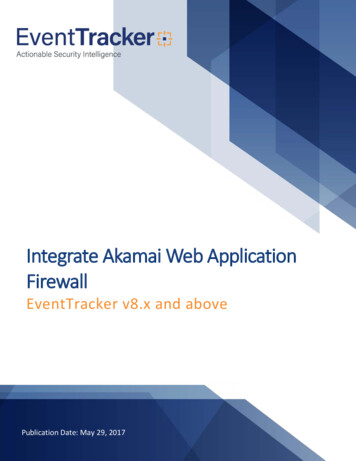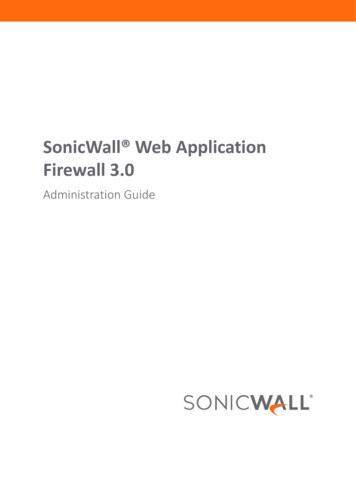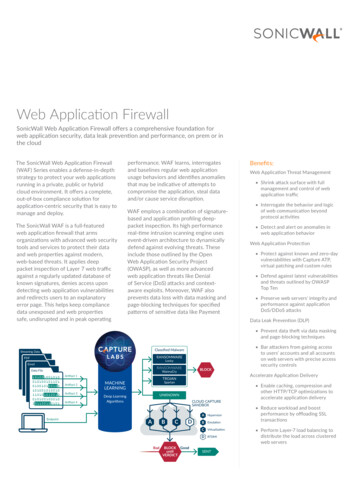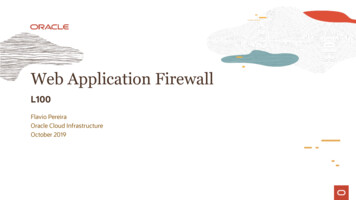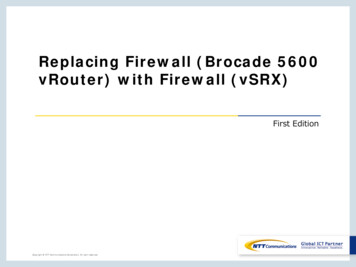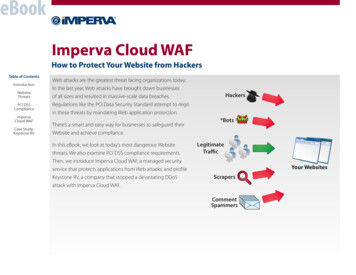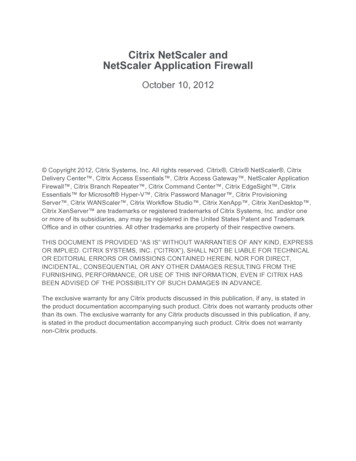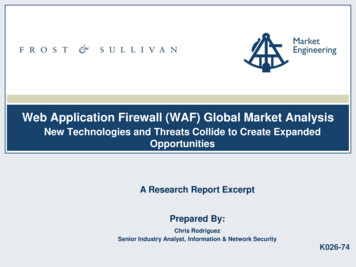
Transcription
Web Application Firewall (WAF) Global Market AnalysisNew Technologies and Threats Collide to Create ExpandedOpportunitiesA Research Report ExcerptPrepared By:Chris RodriguezSenior Industry Analyst, Information & Network SecurityK026-74K026-741
Market Overview Web Applications and the Threat Landscapeo Web applications are valuable tools for businesses of all sizes. These applicationsenable businesses to communicate with customers, potential customers, employees,partners, and other information technology (IT) systems.o By definition, Web applications must be open, interactive, and accessible from allparts of the world and at all times of the day.o Network security technologies such as NGFWs or intrusion prevention systems (IPS)have very limited insight or control over Web traffic. As a result, Web applications areparticularly vulnerable components in an IT infrastructure.o Most organizations have taken basic steps to protect their Web applications, includingdeploying WAF and testing and patching application vulnerabilities.o WAF operates at the application layer and can analyze full sessions and applicationlayer protocols that an IPS cannot see. WAF solutions deployed as full reverse proxies can alter the contents of applicationlayer traffic and sessions to filter attack traffic or insert security controls. WAF also provides a means to deploy a virtual patch to protect an application until itcan be patched.Source: Frost & SullivanK026-742
Market Overview (continued) Web Application Firewall Trajectoryo Early WAF solutions focused on preventing exploitation of application vulnerabilitiesand defending against the Open Web Application Security Project (OWASP) Top 10threats such as cross-site scripting and SQL injection.o Yet, Web threats have evolved tremendously over the years. Hackers have movedfrom simple attacks to more sophisticated or efficient automated attacks thatchallenge legacy security tools.o Furthermore, WAF solutions were difficult to deploy for many customers. WAF solutions require time and technical expertise to deploy and maintain. Web applications change frequently and present a “moving target” for the WAF. Early WAF solutions were prone to high rates of distracting false positives.o As a result, WAF vendors made significant investments in research and developmentof new detection technologies and integration with dynamic application security testingtools.o WAF vendors have addressed many of these challenges in recent years.Source: Frost & SullivanK026-743
Market Overview (continued) Market Outlooko Advanced threat actors are leveraging automated attacks and logic-based exploits,which require modern WAF solutions to properly address.o The risk of catastrophic security breach increases dramatically without a WAFdeployment. Many customers now understand the need for a WAF.o Certain industry regulations specifically require businesses to deploy WAF.o Additionally, new Web technologies such as HTTP 2.0, Extensible Markup Language(XML), and JavaScript Object Notation (JSON) require modern WAF technologies.o Consequently, demand for WAF is growing. Challengeso While demand for WAF grows, the WAF market continues to evolve.o Businesses increasingly expect WAF to be an integrated component of ADCs, CDNservices, distributed denial of service (DDoS) attack mitigation services, and NGFWs.o While stand-alone WAFs will provide the leading security technologies, integratedWAF can meet the needs of many organizations.o There is also an expansion in the tool sets required to secure Web applications suchas bot detection and management capabilities.Source: Frost & SullivanK026-744
Market Overview (continued) The State of the WAF Marketo Currently, the WAF market is represented primarily by few pure-play applicationsecurity companies, and networking companies with added WAF functionality.o For example, F5 and Citrix offer modules for WAF and related application securitytechnologies as extensions for their ADC and load balancing products.o Akamai and CloudFlare are two well known CDN service providers that offer Websecurity in addition to their application delivery and performance solutions.Source: Frost & SullivanK026-745
DriversMarket DriversWAF Market: Key Market Drivers, Global, 2016–20201–2 years3–4 years5 yearsWAF solutions are necessary for compliance with industry andgovernment regulationsHHHCustomers understand the need to protect Web applicationsHHMVendors have addressed customer concerns about usability andeffectivenessHHMConvergence of security and performance solutions enhancescustomer valueHHMEncryption and new Web technologies require modern WAFprotectionsHMLWeb applications are increasingly important to businessesMHHNote: Drivers & Restraints are ranked in order of impact. Source: Frost & SullivanK026-746
Drivers Explained WAF solutions are necessary for compliance with industry and government regulationso Certain industry and government regulations require deployment of a WAF solution, either explicitlyor implicitly. For example, the Payment Card Industry Data Security Standard (PCI-DSS) is a wellknown and important regulation that drives WAF adoption. Section 6.6 specifically outlines WAF as one of two options for securing Web applications.According to the PCI Security Standards Council, “WAF functionality can be implemented insoftware or hardware, running in an appliance device, or in a typical server running a commonoperating system. It may be a stand-alone device or integrated into other networkcomponents.”* The other option, application security testing, may not be a feasible option for businesses thatdo not own the source code or in cases where a large number of applications or updates makeregular testing and patching cost prohibitive. Companies that fail to meet PCI-DSS requirements may be subject to penalties that includefines and suspended privileges.o Other regulations contributing towards WAF adoption include the: Gramm-Leach-Bliley (GLB) Act Health Information Technology for Economic and Clinical Health (HITECH) Act Health Insurance Portability and Accountability Act (HIPAA) National Institute of Standards and Technology (NIST 800–53, Rev.4)*Source: PCI DSS Requirement 6.6: Code Reviews and Application Firewalls, PCI Security Standards Council, Feb. 2008.Source: Frost & SullivanK026-747
Drivers Explained (continued) Customers understand the need to protect Web applicationso Businesses are negatively impacted by data breaches in a number of ways: Lost end-user trust resulting in reduced Web traffic. End users become wary of shopping online or sharing personal information with onlinebusinesses. Lawsuits, settlements, penalties, and fines in the millions of dollars.o Additionally, WAF customers are generally aware of the need for a dedicated WAF solution toaddress application layer-based threats.o WAF is now considered an essential security tool along with NGFW, IPS, endpoint security,vulnerability management, security information and event management (SIEM), and encryption.**Data about the information and network security markets is provided in theEnterprise Security Tracker 2016, Frost & Sullivan, February 2016, available here.Source: Frost & SullivanK026-748
Drivers Explained (continued) Vendors have addressed customer concerns about usability and effectivenesso WAF has a track record of difficult and failed deployments for multiple reasons as discussed in therestraints section here.o In order to lower barriers to adoption, WAF vendors have focused on minimizing the pain pointstraditionally associated with WAF such as deployment difficulty and security ineffectiveness.o Features such as dynamic application profiling enable rapid and simplified deployment. Cloud-based services can be deployed in minutes and are offered as fully managed securityservices.o In recent years, WAF vendors have invested heavily in improving the threat detection capabilitiesof their products including threat detection algorithms, threat research, and device reputationcapabilities. As a result, false positive rates are minimal across all products. WAFs can now be deployedreliably in full blocking mode.Source: Frost & SullivanK026-749
Drivers Explained (continued) Convergence of security and performance solutions enhances customer valueo Applications that are unavailable, slow, or untrustworthy approaches uselessness to end users andcan drive customers to competing Web sites. Businesses require solutions to all of thesechallenges equally.o Essentially, application security and performance tools have similar end goals—to ensureavailability of a Web site and applications for end users by meeting minimum expectations forspeed, functionality, and trustworthiness.o As a result, WAF is often offered as an add-on module for ADCs, load balancers, or NGFWs. Many CDN service providers offer WAF as an additional, optional service. WAF and DDoS mitigation solutions provide a degree of overlapping functionality for protectingWeb applications. However, neither is effective as a total replacement for the other.*o The convergence of WAF and application delivery and performance applications will enhancecustomer value and help customers to justify their investments.*For more data and analysis of the DDoS mitigation market please read DDoSMitigation Global Market Analysis, Frost & Sullivan, November 2015, available here.Source: Frost & SullivanK026-7410
Drivers Explained (continued) Encryption and new Web technologies require modern WAF protectionso XML and JSON are examples of new Web technologies that present challenges for legacy WAFs. These technologies require WAFs that can validate these transactions and detect specificattacks against these technologies.o HTTPS, the encrypted version of HTTP, is increasing in prevalence. Up to 24% of Web traffic isnow represented by HTTPS, according to the HTTP Archive.HTTPS Requests (%)30%20%10%0%201020112012201320142015o The increase in encrypted Web traffic will challenge cloud WAFs and appliances in different ways. Cloud WAF providers will require customers to share their private Secure Sockets Layer (SSL)keys with them, which some customers may be wary to do. Appliances can perform SSL inspection but will require specialized hardware to keep up with theprocessing demands needed to decrypt, inspect, and then re-encrypt traffic.o Additionally, HTTP/2 will not explicitly require encryption of all traffic but to date, browsers do notsupport unencrypted HTTP/2 traffic.Source: Frost & SullivanK026-7411
Drivers Explained (continued) Web applications are increasingly important to businesseso Web properties are essential lines of communications with customers, partners, and investors.o Web sites allow businesses to reach a global marketplace easily and Web applications provide thefunctionality to interact with end users. A registration form and login are examples of Web applications that are common across alltypes of industries around the world. Some businesses utilize vertical-specific applications such as a shopping cart application in theretail industry or a mortgage calculator in the financial industry.o Web applications are growing in complexity as tracked by The HTTP Archive.Source: Frost & SullivanK026-7412
Competitive EnvironmentTotal WAF Market: Competitive StructureGlobal, 2015Number of Companies in the Market20Competitive FactorsAccuracy, advanced features, integration, usability, scalability,cost of ownershipKey End-user GroupsInformation security, development, operations teamsMajor Market ParticipantsAkamai, F5 Networks, ImpervaMarket Share of Top 3 Competitors56.0%Other Notable Market ParticipantsBarracuda Networks, Citrix, CloudFlare, Fortinet, NSFOCUS,Penta Security, RadwareDistribution StructureVARs and systems integrators, distributors, directSource: Frost & SullivanK026-7413
Competitive Environment Discussion The WAF market is dominated by a handful of vendors.o Akamai, F5 Networks, and Imperva maintain the majority of market revenue and aretypically on customer “short lists.” WAF is an important strategic component for companies that develop and sell ADCs,load balancers, NGFWs, and CDN services.o There are few pure-play WAF vendors. The Frost & Sullivan report titled “Network Security Platform Managed Security ServiceProvider (MSSP) Vendor Rankings for North America” provides insight into the WAFsthat are most deployed by MSSPs to offer as managed security services to customers asshown on the following slide.*o MSSPs are just one of many WAF purchasers but offer an interesting perspective onthe competitive landscape.o MSSPs typically require solutions that are highly scalable, reliable, and provideleading security efficacy.*2015 Network Security Platform Managed Security Service Provider (MSSP) VendorRankings for North America, Frost & Sullivan, February 2016, available here.Source: Frost & SullivanK026-7414
Competitive Environment Discussion (continued)Explanation of methodology1.The security platforms supported by MSSPs are weighted by MSSP market share toproduce aggregate ranking.2.The aggregate rankings are then normalized on a 10-point scale. “10” represents themost highly used security platform overall.Source: Frost & SullivanK026-7415
Competitive Factors and AssessmentTotal WAF Market: Competitive Factors and Assessment, Global, 2015Competitive FactorCustomer RequirementsAccuracy Protection against OWASP Top 10 ThreatsLow false positive rates with behavior-based detection enabledThird-party testing and certificationAdvanced Features Bot detectionDevice reputationAnti-scrapingFraud detectionWeb site defacement preventionDDoS detection and mitigationDynamic Web application profilingCustom/third-party rule sets WAF integrates with or offered as optional add-on module for ADCs, NGFWs,and CDN servicesIntegration with advanced malware solutions and DDoS mitigation solutionsBi-directional integration with DAST tools (both static and dynamic)Integration Source: Frost & SullivanK026-7416
Competitive Factors and Assessment (continued)Total WAF Market: Competitive Factors and Assessment, Global, 2015Competitive FactorCustomer RequirementsUsability Out-of-the-box rule setsEase-of-deploymentVirtual and cloud appliances for protection of applications in all environmentsManaged security servicesScalability Use of purpose-built hardware to accelerate functions such as SSL inspectionHigh availability features and fail-open deployment modesMinimal impact on end user experienceCost of ownership Product pricesLower total cost of ownershipRequires fewer security experts to deploy and operateSource: Frost & SullivanK026-7417
Competitive Factors and Assessment DiscussionAccuracy The high false positive rates of early WAF products has been a challenge for the market.o False positive rates can be minimized by disabling rule sets and behavior based detection.However, this compromises the security posture of the Web application. Ideally, customers should be able to deploy a WAF with full behavioral detection enabled withminimal false positive rates. Third-party testing can provide a balanced and impartial approach for customers to determine theaccuracy of available WAF solutions.Source: Frost & SullivanK026-7418
Competitive Factors and Assessment Discussion(continued)Advanced Features Early WAFs and integrated WAFs offer basic protection against simple attacks such as SQL injectionand cross site scripting. However, modern WAFs must provide the functionality to defend against new threats.o Advanced features such as bot detection, device reputation and fingerprinting, anti-scraping,fraud detection, Web site defacement prevention, and DDoS mitigation all help to detect moresophisticated attacks, automated attacks, or unwanted devices, bots, and malicious users. More technically sophisticated customers may require the ability to create custom rule sets. Some features such as dynamic Web application profiling can help to simplify deployment while alsoimproving security.o For example, dynamic Web application profiling allows the WAF to analyze and protect Webapplications such as identifying pages that might be exploited in “heavy URL” DDoS attacks.Source: Frost & SullivanK026-7419
Competitive Factors and Assessment Discussion(continued)Integration WAF is often considered in relation to other application delivery and security tools such as ADCs,NGFWs, and CDN services.o The strength of these related products may determine which WAF a customer will invest in. Vendors such as Fortinet are integrating WAF data with advanced malware sandboxing solutions toidentify advanced threats that can evade point products. WAF can aid DDoS mitigation solutions by identifying and stopping application layer attacks. DDoSmitigation solutions that rely solely on network traffic sampling and metadata lack visibility intoapplication layer traffic.o Security labs report that application layer attacks such as HTTP GET floods and HTTP POSTfloods are becoming more popular. More sophisticated businesses also benefit from bi-directional integration with application securitytesting tools (both static and dynamic). This integration will enable customers to protect applicationvulnerabilities with virtual patches until a software patch can be developed and deployed.Source: Frost & SullivanK026-7420
WAF Service Segment—Revenue ForecastWAF services meet the needs of an underserved and growing market segment.WAF Service Segment: Revenue Forecast,Global, 0Revenues ( M)Units ('000s)Units (000s)Revenue ( 1.516.42020388.118.50YearNote: All figures are rounded. The base year is 2015. Source: Frost & SullivanK026-7421
WAF Service Segment—Revenue Forecast Discussion WAF services provide many advantages over appliances.o WAF services replace a large capital investment with a manageable operationalexpense.o WAF services can be deployed quickly, in a matter of hours instead of days or weeks.o The price for WAF services include maintenance and support.o WAF services are often provided as an add-on to CDN services or include valuableapplication delivery and acceleration capabilities. These benefits allow a previously underserved market segment to deploy WAFcapabilities. The WAF services segment is limited by free WAF services and value-adding WAFcapabilities.o Though these services include a very basic type of WAF, this may be adequateprotection for smaller businesses.Source: Frost & SullivanK026-7422
WAF Service Segment—Pricing Trends and ForecastWAF services are steadily increasing in price as vendors penetrate large businessaccounts.Average Price for WAFService Segment: Global, 2012–20202582065154103Growth Rate (%)Average Price ( ‘000s)72510Average Price ( '000s)Growth Rate YearNote: All figures are rounded. The base year is 2015. Source: Frost & SullivanK026-7423
Service Segment—Pricing Trends and ForecastDiscussion WAF services cost less than appliances but are a recurring monthly or yearly expense.o Entry level WAF services start at a couple hundred dollars per month per Web site.o Enterprise subscriptions can cost several thousand dollars depending on the numberof Web sites and applications that require protection. Additionally, WAF services require less technical expertise to deploy and maintain. WAF service contracts also include updates and support in the subscription price. Increasing penetration into larger business and enterprise accounts is driving steadygrowth in average price.Source: Frost & SullivanK026-7424
Service Segment—Market ShareAkamai has established a leadership position in the WAF services market.Pe
Source: Frost & Sullivan Market Overview . o By definition, Web applications must be open, interactive, and accessible from all parts of the world and at all times of the day. o Network security technologies such as NGFWs or intrusion prevention systems (IPS) . WAF solutions deployed as f

